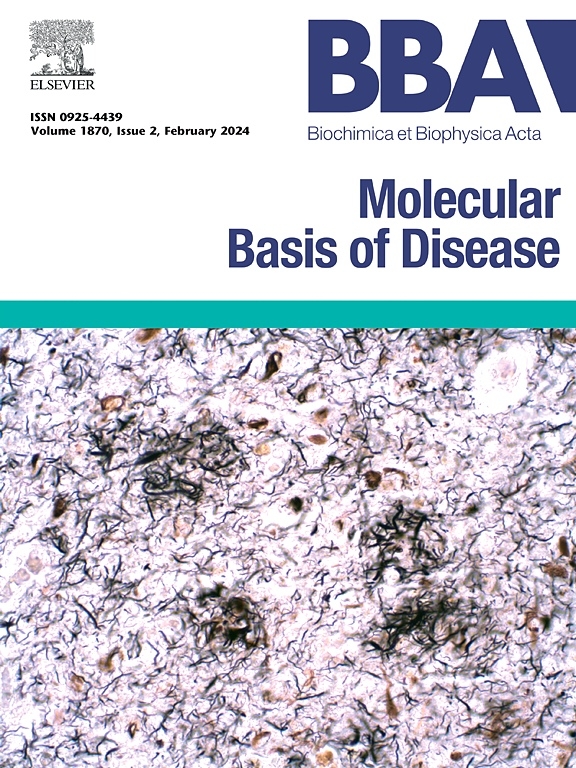High MICAL-L2 promotes cancer progression and drug resistance in renal clear cell carcinoma cells through stabilization of ACTN4 following vimentin expression
IF 4.2
2区 生物学
Q2 BIOCHEMISTRY & MOLECULAR BIOLOGY
Biochimica et biophysica acta. Molecular basis of disease
Pub Date : 2024-12-15
DOI:10.1016/j.bbadis.2024.167628
引用次数: 0
Abstract
Targeted therapies persist as the conventional method of treatment of kidney clear cell carcinoma (KIRC). However, resistance to these drugs emerges as a significant impediment to the management of renal cancer. MICAL-L2 plays a pivotal role in cytoskeleton rearrangement. This study sought to elucidate the clinical relevance of MICAL-L2 in KIRC and its regulatory mechanism driving cancer progression and resistance to therapy. TCGA data mining was utilized to assess the expression of MICAL-L2 in samples from patients with KIRC. Kaplan–Meier analysis and immunohistochemistry were employed to explore the clinical significance of MICAL-L2. In vitro experiments, including assays for wound healing and Transwell migration, CCK-8, EDU staining, RT-PCR, flow cytometry, and co-immunoprecipitation analysis were conducted to investigate the effects of MICAL-L2 on the drug sensitivity of KIRC cells and to elucidate the molecular mechanisms involved. The results showed that MICAL-L2 was overexpressed in KIRC tissues. High levels of MICAL-L2 were associated with poor survival and a poor response to drug therapy among patients with KIRC. Overexpression of MICAL-L2 stimulated cell migration, proliferation, and rendered KIRC cells insensitive to sunitinib and everolimus, two traditional therapies for KIRC. Furthermore, MICAL-L2 overexpression accelerated cancer progression and resistance to therapy in KIRC cells by interacting with its downstream regulator α-actinin-4 (ACTN4) in a Rab13-dependent manner, which reduced the degradation of ACTN4, leading to increased Vimentin expression. All these findings indicate that MICAL-L2 plays a crucial role in the progression of KIRC and suggest that MICAL-L2 may serve as a potential therapeutic target for KIRC treatment.

高MICAL-L2通过稳定vimentin表达后的ACTN4促进肾透明细胞癌细胞的癌症进展和耐药。
靶向治疗仍然是治疗肾透明细胞癌(KIRC)的常规方法。然而,对这些药物的耐药性成为肾癌治疗的一个重大障碍。MICAL-L2在细胞骨架重排中起关键作用。本研究旨在阐明MICAL-L2在KIRC中的临床相关性及其驱动癌症进展和耐药的调节机制。利用TCGA数据挖掘来评估MICAL-L2在KIRC患者样本中的表达。应用Kaplan-Meier分析和免疫组织化学方法探讨MICAL-L2的临床意义。体外实验通过伤口愈合和Transwell迁移、CCK-8、EDU染色、RT-PCR、流式细胞术、共免疫沉淀分析等方法研究MICAL-L2对KIRC细胞药物敏感性的影响,并阐明其分子机制。结果显示MICAL-L2在KIRC组织中过表达。在KIRC患者中,高水平的MICAL-L2与较差的生存率和对药物治疗的不良反应相关。MICAL-L2的过度表达刺激了细胞迁移、增殖,并使KIRC细胞对舒尼替尼和依维莫司这两种传统的KIRC疗法不敏感。此外,MICAL-L2过表达通过与下游调节因子α-actin -4 (ACTN4)以rab13依赖的方式相互作用,加速了KIRC细胞的癌症进展和对治疗的耐药性,从而减少了ACTN4的降解,导致Vimentin表达增加。所有这些发现表明MICAL-L2在KIRC的进展中起着至关重要的作用,并提示MICAL-L2可能作为KIRC治疗的潜在治疗靶点。
本文章由计算机程序翻译,如有差异,请以英文原文为准。
求助全文
约1分钟内获得全文
求助全文
来源期刊
CiteScore
12.30
自引率
0.00%
发文量
218
审稿时长
32 days
期刊介绍:
BBA Molecular Basis of Disease addresses the biochemistry and molecular genetics of disease processes and models of human disease. This journal covers aspects of aging, cancer, metabolic-, neurological-, and immunological-based disease. Manuscripts focused on using animal models to elucidate biochemical and mechanistic insight in each of these conditions, are particularly encouraged. Manuscripts should emphasize the underlying mechanisms of disease pathways and provide novel contributions to the understanding and/or treatment of these disorders. Highly descriptive and method development submissions may be declined without full review. The submission of uninvited reviews to BBA - Molecular Basis of Disease is strongly discouraged, and any such uninvited review should be accompanied by a coverletter outlining the compelling reasons why the review should be considered.

 求助内容:
求助内容: 应助结果提醒方式:
应助结果提醒方式:


